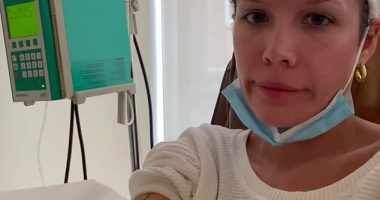Though both heat rash and sun poisoning look slightly similar, they’re pretty different—and one is far more serious, says Jennifer Gordon, MD, a board-certified dermatologist with Westlake Dermatology in Austin, Texas. Here’s how to figure out what you’re dealing with, how to treat it, and when to see a doctor about your post-sunshine rash.
In This Article
Experts In This Article
What is heat rash?
A heat rash (also known as prickly heat or miliaria) is a red rash marked by small, blister- or pimple-like bumps and itching, per the Mayo Clinic. In some cases, it can also cause mild swelling or burning. “This happens when sweat gets trapped in the skin, most commonly from heat, humidity, or clothing,” says Dr. Gordon. It’s common in babies—who can get sweaty from being over-bundled—but kids and adults can also be affected, especially on hot, sticky days. (Even a hot shower or session of hot yoga causes heat rash for some people!)
Heat rash symptoms usually hit in areas where you skin folds together, according to the Cleveland Clinic. Think your arms or legs, neck, back, groin, underarms, inner thighs, or under your breasts. You can also get it in spots where your clothes are pressing up against your skin for long periods, like around your waistband.
Keep in mind: This is not to be confused with heat stroke, which is a serious heat-related illness that needs to be treated right away. It can cause confusion, loss of consciousness, hot, dry skin, and a very high body temperature, per the Centers for Disease Control and Prevention (CDC). To differentiate between heat stroke vs sun poisoning, in particular, you’ll want to take a closer look at your skin (more on this below).
What is sun poisoning?
Sun poisoning is a body-wide reaction to a severe sunburn. While sun poisoning doesn’t cause a rash, a severe burn can lead to large sun blisters (usually from sweat trapped under the sunburn) and peeling skin. You might also get the following symptoms, per Dr. Gordon:
- Headache
- Dizziness
- Nausea
- Fatigue
- Dehydration
- Swelling
- Fever or chills
Sun poisoning signs usually happen within several hours of being out in the sun. “This can become very dangerous, and in severe cases require hospitalization,” Dr. Gordon says.
But sun poisoning doesn’t actually mean a person is poisoned. Like milder sunburns, it’s caused by overexposure to the sun’s UV rays. Experts aren’t sure why some people have this kind of extreme reaction to a sunburn, the Cleveland Clinic notes, but people with fair skin and those with a family history of skin cancer seem to be at higher risk.
It’s also hard to say whether a very bad sunburn will develop into sun poisoning, Dr. Gordon adds. This is why it’s best to take care of your burned skin, help it heal, and be on the lookout for any general, body-wide feelings of sickness that could mean you’re getting sun poisoning, just in case.
How to tell the difference between heat rash vs sun poisoning
If you know what to look for, it can be easy to tell these two conditions apart. Appearance-wise, heat rash tends to cause small, blister-like bumps under your skin, usually only in areas where you have skin-on-skin contact. A sunburn that leads to sun poisoning will be bright red or pink and may form large, peeling blisters, and it typically develops in spots where you’ve had a lot of direct sun exposure, Dr. Gordon says.
You’ll feel different, too. A heat rash might be a little itchy or swollen, but it won’t typically cause any other symptoms. On the other hand, sunburn that causes sun poisoning is extremely painful and tender to the touch. More importantly? With sun poisoning, you’ll have systemic symptoms that actually feel like you’re sick, notes Dr. Gordon. That’s not the case with heat rash.
How long heat rash lasts is different, too. Essentially, each condition has its own timeline. Heat rash usually clears up within a couple of hours, says Dr. Gordon. But a very severe sunburn can last for days to weeks, with symptoms of sun poisoning starting up within several hours of the sunburn forming.
With sun poisoning, you’ll have systemic symptoms that actually feel like you’re sick.—Jennifer Gordon, MD, dermatologist
How to treat heat rash and sun poisoning
You can almost always handle a heat rash on your own with a few basic measures. And sun poisoning might be manageable at home, but more intense symptoms usually require medical care.
Heat rash treatment
Because most heat rashes are only mildly annoying, you don’t need to do much to relieve your discomfort. “Cooling down and compresses are usually all you need,” Dr. Gordon says. Try the following methods, according to FamilyDoctor.org:
- Get out of the heat: Air conditioning is best, but even a fan or some shade helps.
- Use a cool compress: It’ll help your skin cool off and relieve any itching.
- Dry your skin: Once you’re done with the compress, leave your skin exposed to open air to stop more sweat from getting trapped.
- Wear loose, comfy clothing: Tight or scratchy fabrics will irritate your skin. Opt for materials like cotton or linen.
- Skip ointments, creams, or baby powders: These products can further block your sweat glands and make the rash worse.
Sun poisoning treatment
Taking steps to soothe your skin ASAP can help a bad sunburn from turning into sun poisoning, says Dr. Gordon. According to the Mayo Clinic, you should:
- Drink plenty of water: Sunburns can cause dehydration, which can contribute to sun poisoning.
- Take a cool bath: Hop in for 10 minutes or so several times a day to help your skin cool off. Adding 2 ounces of baking soda to the tub can offer extra cooling sunburn relief.
- Apply a cooling gel or cream: Aloe vera or calamine lotion will do the trick. They’ll feel even better if you put them in the fridge first.
- Take an OTC pain reliever: Ibuprofen or acetaminophen can help take down some of the swelling and help you feel more comfortable.
- Don’t mess with your blisters: Popping or picking at them could cause an infection. Once your skin starts to peel on its own, slather on the moisturizer to help your skin stay hydrated.
If you think your sunburn has turned into sun poisoning, you should seek medical attention. By that point, dehydration is likely to set in, and you may need IV fluids to restore your hydration levels. Your doctor can also examine your skin to see if you need other treatments to help the sunburn heal, like steroids or antibiotics, per the Cleveland Clinic.
Preventing heat rash and sun poisoning
While it’s totally okay to indulge in a bit of summer sunshine, it’s best to say “no” to overexposure to the heat and sun, Dr. Gordon says. Limiting your time in hot, humid environments and wearing loose, breathable clothing can help reduce your risk for heat rash and help your skin stay dry, per FamilyDoctor.org.
And steering clear of summer skin hazards—like sun poisoning—comes down to avoiding sunburns in the first place. Per the CDC, you can protect your skin by:
- Wearing sunscreen and reapplying every two hours, to avoid UV exposure effects. (Check out the winners of our SPF awards for top-notch recs!)
- Staying in the shade when the sun’s rays are strongest—usually between 10 a.m. and 4 p.m.
- Wearing sun-protective clothing, like a hat (no scalp sunburn for us!) and sunglasses.
- Staying hydrated and getting indoors, especially if you notice your skin is starting to burn.
When to see a doctor
If you have any signs of sun poisoning, it’s best to seek medical attention, because you could be severely dehydrated. “If sunburn is causing systemic symptoms, especially severe dehydration, pain, vomiting, or disorientation, then you likely need to go to the ER,” Dr. Gordon says.
As for heat rash? While it typically goes away on its own once you’ve cooled off, let your dermatologist know if the rash doesn’t ease up after a few days, or if you get worsening symptoms. It’s possible the rash is from something else, or has gotten infected and needs antibiotics.
FAQ
Will sun poisoning go away on its own?
Sunburns, even relatively bad ones, will usually go away with at-home care within a week or so. But a burn that’s turned into sun poisoning typically needs medical treatment. You might need IV fluids for dehydration, along with steroids or antibiotics to help your burned skin heal.
What rash can be mistaken for heat rash?
Heat rash looks similar to polymorphic light eruption (aka, sun rash). This rash is caused by sun exposure that happens in people who are particularly sensitive to sunlight. Like a heat rash, it can lead to small, blister-like bumps and itching, according to the National Library of Medicine. But this type of sun allergy usually only forms on areas where the skin is exposed to sunlight, rather than skin folds that generate a lot of sweat.
According to the NHS, sun rash can last for up to two weeks, and appear within minutes of sun exposure. If you’re wondering how to treat sun rash, start by avoiding sudden exposure to lots of sunlight, wearing protective clothing, and seeing your doctor for other relief options, per the Mayo Clinic.
Source: Well and Good





